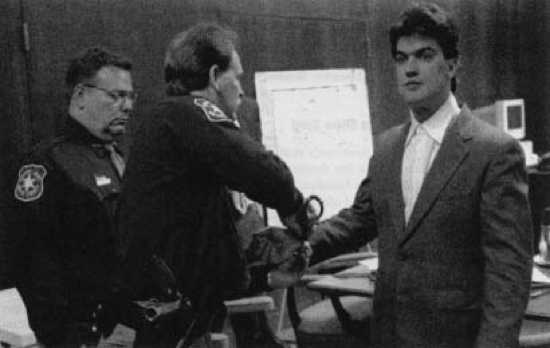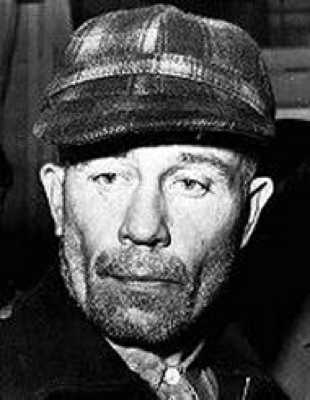Nonetheless, the insanity defense as a strategy is fascinating. Its validity has been widely debated since its inception in the 20th century, mainly due to the difficulty in proving beyond a reasonable doubt that the criminal was insane during the commitment of their crimes. There are also ethical implications of allowing deranged criminals to avoid incarceration. The following list explores some of the most notorious cases and debunks some of their popular misconceptions at the same time.
In 1941, the two brothers robbed a payroll truck in Manhattan and killed an office manager and a police officer in the process. In the subsequent trial, the brothers attempted to prove their insanity through extreme behavior. For example, they would bang their heads against the table until they bled, bark like dogs, drool, and cry uncontrollably. The court was unconvinced and proceeded to charge them for their offenses. Towards the end of their incarceration, they pursued a hunger strike for a total of 10 months, refusing any food. On the 12th of March 1942, they were taken to the electric chair in a state of near-death and executed. To this day, the Espositos’ trial verdict remains a record for deliberation, which took approximately one minute to deliver. In its time, it served to correct the misconception that criminals who plead an insanity defense often walk as free men, which is rarely the case. Even if a person was determined to be mentally ill, a study at a mental institution in New York found that some patients spent a far longer amount of time committed than they would have spent in prison for their crimes.
This was the first use of the insanity plea in the United States. Daniel Sickles was known for being a New York politician and Civil War Union General as much as his public scandals and controversies. He married Teresa Bagioli when he was 33. She was 15 at the time. This was also the same man who chose not to present his pregnant wife at home to Queen Victoria but instead hired the services of a common prostitute, Fanny White, for the dignified task. However, his greatest scandal came when he shot and killed Philip Barton Key in Lafayette Park for having an affair with said wife, Teresa. In the much-publicized trial, he claimed temporary insanity as he was enraged with his wife’s infidelity at the time. Before an all-male jury, Daniel Sickles was acquitted of murder charges in 1859. In the aftermath of the trial, the public was not only nonchalant to the outrageous claim but applauded his actions for liberating the ladies of Washington from the adulterer Philip. Coincidentally, Philip was also the son of Francis Scott Key, the writer of “The Star-Spangled Banner.”
In 1981, Steinberg was charged with killing his wife, Elena, with a kitchen knife. Elena was stabbed 26 times. It should also be noted that Steinberg was the one who called the police reporting an attempted burglary gone awry, though the police found no signs of a break-in. The case drew much publicity in Arizona not only for the heinous crime but because it was a case of homicidal somnambulism, or simply known as sleepwalking murder. To quote legal argument, “The defendant was not in his normal state of mind when he committed the act. Sleepwalking is parasomnia manifested by automatism; thus, harmful actions committed while in this state cannot be blamed on the perpetrator.” Steinberg claimed he did not remember the crime and was sleeping at the time, hence the murder while sleepwalking. Not only that, he did not deny the fact that he murdered his wife. In his criminal trial, the jury found him not guilty because he was temporarily insane when he committed the crime. Although Steinberg fabricated the story about the intruders, he walked away as a free man. Members of the jury were also quoted later as saying they were aware that they were releasing a killer, but he was not criminally responsible for his actions.
Andrea Yates was convicted in 2002 for the capital murders of three of her five children and sentenced to life in prison, where she was to serve at least forty years. Yates’s life appeared normal; she was an athlete, a college graduate, and a registered nurse. But, in 2001, the world learned about Yates’s inner struggles when she filled a bath with water and methodically drowned, one by one, her five children: Noah, 7 years old; John, 5 years; Paul, 3 years; Luke, 2 years; and Mary, who was just 6 months. She then phoned the emergency services and asked the police to come to the house. She also called her husband, Rusty, at work and told him he needed to come home. When a police officer arrived and asked her what was wrong, she immediately told him, “I killed my kids.” In 2005, her conviction was overturned, and a new trial was ordered. Yates was retried in 2006 and found not guilty of murder by reason of insanity. Yates had a long medical history of suffering from severe postpartum depression and postpartum psychosis. She experienced episodes of psychotic behavior after the birth of each of her children. In jail, she claimed she had considered killing the children for 2 years. Yates also claimed she was not a good mother and that she was marked by Satan. And the only way to save her children from hell was to kill them. Even though she sought treatment for a mental disorder, Yates said she wasn’t depressed because she never cried. Yates’s attorneys insisted that her post-partum depressions played a significant role in her actions. Her case also shed light on the inadequate insurance coverage for people with mental health disorders. Just weeks before the murders, Yates was released from a mental hospital because her insurance stopped paying. She was told by her psychiatrist to think happy thoughts. Despite warnings from her doctors, she was left alone with the children. This was one of the cases when the plea, innocent by reason of insanity, was justified.
The next entry on the list is probably the most famous one yet. In 1981, Hinckley developed an obsession with the movie Taxi Driver, in which Jodie Foster stars as a child prostitute, and Robert De Niro plays Travis Bickle, who plots to assassinate the presidential candidate in the film. He personally watched the movie 15 times consecutively and grew infatuated with Jodie Foster. Hinckley then began to stalk the actress by relocating to New Haven, Connecticut, near Yale University, where she was enrolled. He signed up for a Yale writing class, slipped her poems and messages through her door, and called her persistently. As he grew more desperate in his attempts, he even considered taking his own life in front of her to gain her attention. Eventually, he decided to attempt an assassination on President Ronald Reagan. As the president left the Hilton Hotel, he shot six times at Reagan, wounding a few other people in the process. One of the bullets hit the president in the chest, but he survived the attempt. Hinckley’s defense team pled for an insanity defense and succeeded; he was acquitted of all 13 charges of assault, murder, and weapon counts. Due to the high profile of the case, the public perceived the insanity defense as a loophole in the legal system, which allowed a clearly guilty criminal to dodge incarceration. The controversy lay in the fact that before the assassination attempt, the insanity defense was only used in 2 percent of the felony cases and, in those cases, failed over 75 percent of the time. Nonetheless, most states were pressured to enact legislative reforms regarding the use of the insanity defense.
In 1994, Jenny Jones, a national talk show host, was in the midst of producing a program about same-sex crushes. They hunted for people who would openly admit to having a crush on television and found Scott Amedure, who had a crush on his friend Jonathan Schmitz. The show’s producers invited Schmitz to the show, explaining that someone had a crush on him. The producers reasserted that Schmitz was fully aware that the show was about same-sex crushes. Schmitz would later claim that he expected to find his ex-girlfriend on stage but found Amedure instead, who described his sexual fantasy involving Schmitz on the program. Three days later, Amedure left Schmitz a suggestive note. Upon finding the note, Schmitz purchased a shotgun, confronted him, and finally shot him twice in the chest, killing him. This is a special entry because of the defense used, known as the gay panic defense. It is defined as a state of temporary insanity caused by undesirable homosexual advances. It is controversial because it is a little-known psychosis, and its validity is widely debated within jurisdictions. The media then lampooned the case as the Jenny Jones trial. Despite the defense, Schmitz was found guilty of second-degree murder and sentenced to 25 to 50 years in jail. The Jenny Jones Show was also later sued for negligence for creating a hostile scenario without considering the potential consequences. They were found guilty, but the judgment was overturned on appeal.
Lorena and John Bobbitt were a young couple from Virginia. John had a history of mentally and sexually abusing Lorena throughout their marriage. On June 23rd, 1993, John arrived home highly inebriated and proceeded to rape Lorena. After the incident, Lorena stepped into the kitchen for a drink of water and saw a carving knife on the counter. This evoked memories of the years of domestic abuse that had been taking place. Lorena then walked back into the bedroom where John was sleeping and “cut off almost half of his penis” with the knife. With the severed penis in hand, Lorena left the apartment, drove to a field, and threw it away. Finally, she made the call to 911, in which a team then searched for the genitalia and was able to recover it. John was taken to the hospital, and his penis was able to be surgically reattached. During the trial, Lorena revealed the details of their marriage and the domestic abuse. Her defense claimed that she was suffering from clinical depression from it, causing her to wound her husband. The jury deliberated, and Lorena was acquitted of the charges due to temporary insanity and could not be held responsible for her actions. She was, however, ordered to undergo psychiatric evaluation for 45 days and was released thereafter. In the aftermath of the much-publicized trial, she appeared on the Oprah Winfrey Show to talk about her experience and has since been an advocate for domestic violence causes.
Dahmer was a notorious serial killer and sex offender in 1991. His long list of offenses involved sex, cannibalism, necrophilia, and dismemberment. Since he was a child, he had shown symptoms of withdrawal and avoidance of any social interactions. He would collect dead animals, then dissect, dissolve, or mutilate them in various ways. He committed the first murder in 1978, bludgeoning to death Steven Hicks, a hitchhiker, because “the guy wanted to leave, and I didn’t want him to.” In September 1987, he picked up Steven Tuomi at a gay bar and killed him out of impulse, claiming no memory of the event later in the trial. In 1988, he was also arrested for giving drugs and sexually fondling a 13-year-old boy, Somsack Sinthasomphone. As a registered sex offender, he would then proceed to commit 15 more murders, storing the corpses in vats. Dahmer kept trophies of his victims, such as human skulls and genitalia in the closet and “saving” biceps and the human heart in the freezer for later consumption. In 1991, Tracy Edwards, a would-be victim, overpowered Dahmer, ran through the streets, and waved for the police car. In the trial, Dahmer pled not guilty by reason of insanity. The plea was subsequently rejected, and Dahmer was convicted of all 15 murder charges and sentenced to 15 consecutive life sentences. The case was seen by many as the death of the insanity plea. They contended that if a deranged criminal like Dahmer is rejected on the insanity plea, no other criminal would qualify to use the defense.
Gacy was a prolific serial killer in the 1970s in the U.S. He gained notoriety as the Killer Clown for dressing up as “Pogo the Clown” and performing at parties and events. He later raped and killed 33 young boys and men in Chicago. He claimed that he lost count of how many of his victims he had buried in a crawl space he dug and reported that he had thrown 5 of them into the Des Plaines River because it had run out of room. The discovery of his murders and subsequent arrest shook the community, as he was known for his active involvement with local projects and his volunteer work as the said clown, even meeting the First Lady Rosalynn Carter who personally thanked him for his efforts. Many of his victims were lured into his home and then murdered through asphyxiation by a tourniquet, not strangulation. This meant that they were cut off from most but not all of the oxygen supply, resulting in the victims convulsing for an hour or two before the eventual death. He pled not guilty by reason of insanity and produced psychiatric experts who would testify for his case. The prosecution team rejected this due to the extensive measures Gacy took in avoiding detection, including ordering his own construction company’s employees to dig the crawl space, which he claimed to be a drainage trench. Also, his defense team actually attempted to argue that all of the 33 murders were due to accidental erotic asphyxiation, a claim which the county coroner quickly refuted. Gacy was found guilty of each murder and was sentenced to death by lethal injection. Even after his sentencing, he continued to draw controversy. During his 14 years spent on death row, Gacy painted various drawings, which were sold for amounts up to $9,500. This drew the ire of the community towards Gacy for making money from the sales and the art exhibitions held in his name, leading to communal bonfires in which the paintings were bought for the sole purpose of being burned. Not only that, but Gacy also inspired films and books which chronicled his killings and life. One of the more notable books was written by Jason Moss, who was so fascinated by serial killers that he established communication with Gacy on death row, pretended to be a gay hustler, visited him face to face, and claimed he was almost Gacy’s final victim. He was dubbed as a serial killer groupie due to his intense fascination, and in 2006, Moss committed suicide from a gunshot to the head.
“They smelled too bad” was a quote from Ed Gein, who claimed that he would never have intercourse with any of the dead bodies he dug out of their graves. What he did take an interest in, however, was skinning the corpses and wearing them. On other occasions, he would collect various body parts and use them as decorative items at his homestead in Wisconsin. For example, a suit made of human skin, a belt made out of female nipples, a lampshade made out of a human face, a refrigerator filled with human organs, vulvas in a shoebox, and many others, including noses, skulls, heads, and a pair of lips on a drawstring. This grave robber was perversely fascinated with his deceased mother and the intimacy of female body parts. In 1957, he was arrested and tried for the murder of Bernice Worden, although he also confessed to killing at least two others but was not charged due to cost issues, according to the judge in his case. Gein pled not guilty by reason of insanity and was deemed legally insane. After an 11-year stint in the hospital for the criminally insane, he was tried in 1968 and was found guilty of first-degree murder. Gein served a life sentence in a mental hospital until his death. Gein gained further notoriety because the county sheriff Art Schley was so horrified by the severity of his crime that he assaulted Gein during questioning. He subsequently suffered a heart attack and died a month after testifying at the trial. In modern-day pop culture, Gein served as character inspirations to a myriad of famous horror movie franchises. Gein tops the list for being most notorious due to the film industry’s obsession with Gein, immortalizing him in seemingly literal depictions of his character such as Leatherface in The Texas Chainsaw Massacre and Buffalo Bill in The Silence of the Lambs, who were fond of grotesque dismemberment and skinning of their victims.
























